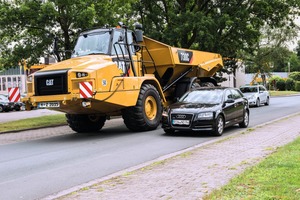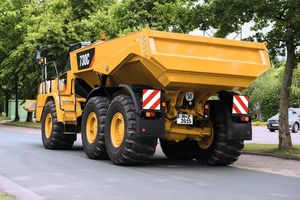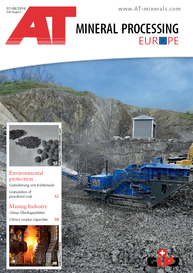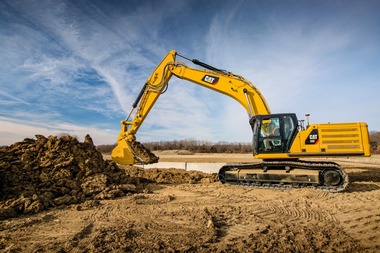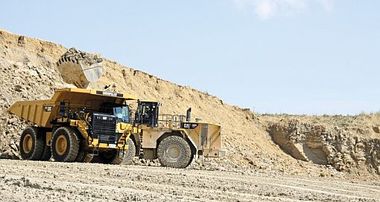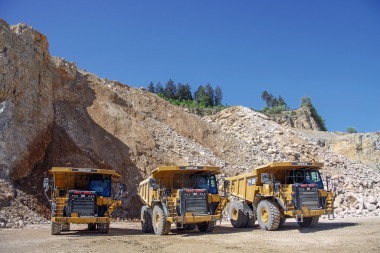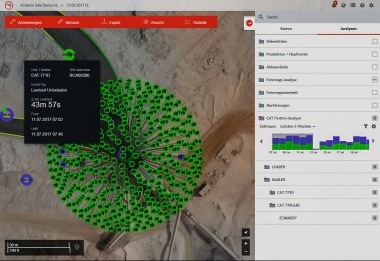Ready for starting on public roads
If in future, car and lorry drivers, cyclists and bikers on Germany’s public roads notice a Cat Dumper 725C or 730C coming towards them, it is not that these heavy construction machines have lost their way. They have neither missed the exit, nor taken the wrong turn on their way to their actual operation sites: quarries, sand and gravel pits as well as large earthwork sites, where they are responsible for the transport of raw and construction materials. As of now, the Zeppelin articulated joint dumpers also come in a street-legal version.
The pilot project of a Cat 730C was realized by Florian Halama, Zeppelin Product Manager for large equipment, in cooperation with the service team of the branch office Achim near Bremen. Various machine tests had to be passed, before the TÜV granted its approval – the braking distance at speeds of 30, 40 or 50 km/h was tested as well as the respective acoustics at various speeds.
“In discussions with the sales department, we repeatedly addressed the topic that – because of the location of the mining sites – customers want to drive the dumpers on public roads to be able to use the equipment at several sites and to improve capacity utilization. So far, however, we were not able to offer a road-legal”, says Halama. This means, there was no other choice left but to either transport the machines by road on low-loaders or to invest in additional equipment. Some manufacturers tried to gain a special authorization from the local authorities, which often entailed a complicated and lengthy – and usually also futile – undertaking.
The MOT approval requires the dumper to be retrofit with a respective wiring harness, which needs to be installed completely anew. However, in the case of dumpers of the C series, Zeppelin can equip both new and existing, already used machinery for road traffic. Zeppelin plans to gain the MOT approval for the 725C and 730C models.
The process of adjusting the pilot dumper 730C in a way to gain the TÜV road approval was rather complex. What might sound easy is actually a great challenge: although an application for a new CE certification was not necessary, because the machine had not been substantially altered within the meaning of the machinery directive, a new switch had to be installed in the driver’s cab which ensures off-switching of the rear dump body. As soon as the driver and his vehicle leave the company’s premises and enter public land, he must flip the switch. This switch locks the control of the rear dump body to prevent its lifting-up during the journey, in case the driver accidentally touches the switch. Due to their axle loads, the construction machines are only allowed empty runs on public roads. With the new switch being flipped, the normal working illumination changes to lighting for road traffic. This required the complete conversion of the light system to turn the construction machines, with a service weight of around 23 t in case of the Cat 725C and of 24 t in case of the Cat 730C, into street-legal vehicles. The result: the rear was equipped with LEDs and the rear lights were laterally installed at the outside in order for following vehicles to recognize immediately what is in front of them. The working lights had to be readjusted, since after all they shall not blind and thus distract other road users.
When dumper tires – whether as standard version type 23.5 R 25 or as wide base tires 750/65/R25 – get into contact with public roads, pollution should be excluded. For this reason, four new mud wings were repositioned to prevent dirt and mud from flying backwards at full speed. And the speed allowed for the articulated dumper had to be throttled from 65 to 50 km/h. “For this reason, driving dumpers on motorways is excluded”, says Halama.
The height of bridges or undergrade crossings, a possible obstacle, is limited by the exhaust pipe which is installed behind the driver’s cab and results in a total height of 3.7 m. “Elevated dump bodies, meanwhile standard on every other dumper in Germany, are no critical height factor that would prevent dumpers from driving on public roads”, Halama explains. Thus, if in future dumpers approach car and lorry drivers, cyclers or bikers, it is completely legitimate.
$(LEhttp://

